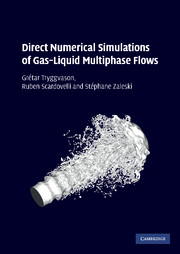Book contents
- Frontmatter
- Contents
- Preface
- 1 Introduction
- 2 Fluid mechanics with interfaces
- 3 Numerical solutions of the Navier–Stokes equations
- 4 Advecting a fluid interface
- 5 The volume-of-fluid method
- 6 Advecting marker points: front tracking
- 7 Surface tension
- 8 Disperse bubbly flows
- 9 Atomization and breakup
- 10 Droplet collision, impact, and splashing
- 11 Extensions
- Appendix A Interfaces: description and definitions
- Appendix B Distributions concentrated on the interface
- Appendix C Cube-chopping algorithm
- Appendix D The dynamics of liquid sheets: linearized theory
- References
- Index
7 - Surface tension
Published online by Cambridge University Press: 07 October 2011
- Frontmatter
- Contents
- Preface
- 1 Introduction
- 2 Fluid mechanics with interfaces
- 3 Numerical solutions of the Navier–Stokes equations
- 4 Advecting a fluid interface
- 5 The volume-of-fluid method
- 6 Advecting marker points: front tracking
- 7 Surface tension
- 8 Disperse bubbly flows
- 9 Atomization and breakup
- 10 Droplet collision, impact, and splashing
- 11 Extensions
- Appendix A Interfaces: description and definitions
- Appendix B Distributions concentrated on the interface
- Appendix C Cube-chopping algorithm
- Appendix D The dynamics of liquid sheets: linearized theory
- References
- Index
Summary
The accurate computation of the surface tension is perhaps one of the most critical aspects of any method designed to follow the motion of the boundary between immiscible fluids for a long time. In methods based on the “one-fluid” formulation, where a fixed grid is used to find the motion, surface tension is added as a body force to the discrete version of the Navier–Stokes equations. Finding the surface force depends on whether the fluid interface is tracked by a direct advection of a marker function (VOF) or whether discrete points are used to mark the interface (front tracking). Here, we describe how to find surface tension for both VOF and front-tracking methods. At the end of the chapter we examine the performance of the various methods and the challenges in computing surface tension accurately and robustly.
Computing surface tension from marker functions
A marker function such as the color function C of the VOF method or the level-set function F is a function that indicates (marks) where the interface is. A whole family of methods for surface tension have been developed for the use of marker functions; however, these methods may also be used in connection with front tracking methods. The standard approach is termed the continuous surface force (CSF) method. We also describe a variant that conserves momentum exactly, the continuous surface stress (CSS) method.
Continuous surface force method
For simplicity, we consider first the case where σ is constant.
Information
- Type
- Chapter
- Information
- Direct Numerical Simulations of Gas–Liquid Multiphase Flows , pp. 161 - 186Publisher: Cambridge University PressPrint publication year: 2011
